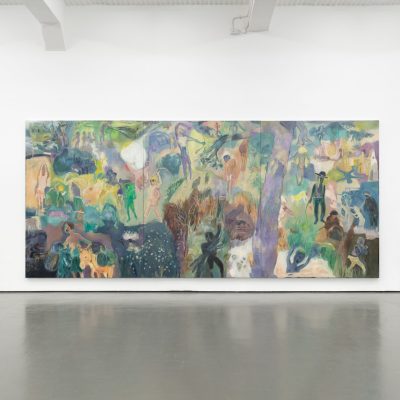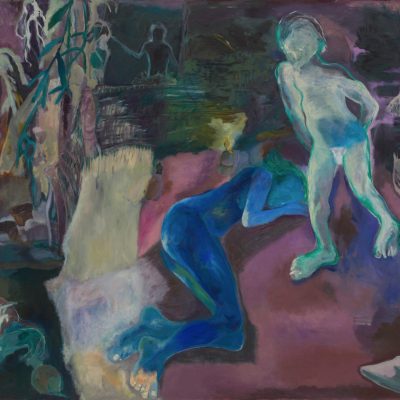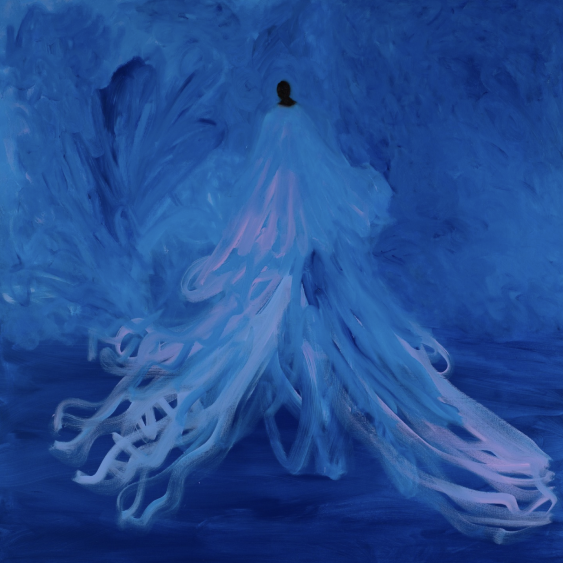Artist of Interest
A brief encounter
with Sosa Joseph
Share






Lush and haunting, Sosa Joseph’s expressionist figurations move between landscape, still life and portraiture studies. A stable, textured medium that affords artists the fluidity of working on a painting (or visual thought) intermittently, oil painting allows Joseph’s work the opportunity to start as a preoccupation before a process of spontaneous and intuitive improvisation catalyses their evolution. A visual response, talking back to generational disremembering, her debut show The Hushed History of Oblivion holds space for the neglected and ultimately forgotten stories of people subjected to the Indian Ocean slave trade. A consideration of “how popular history seems to hush up its brutal past”, this week’s ______ Of Interest uses the exhibition as an opportunity to meet the artist, her processes and practice.
Known for its palm tree-lined beaches and backwaters as well as mountains whose slopes support tea, coffee and spice plantations, Kerala is a state located on India’s tropical Malabar Coast. For Sosa Joseph, one of Stevenson’s newly signed artists, it’s home. Describing her upbringing in the Kuttanad region of Kerala, Joseph starts with the certitudes including how Kuttanad is perhaps the lowest-lying land in India and one of the few places in the world where farming happens below the sea level. Invested in an approach to image-making that reconciles figuration with abstraction, Joseph then goes on to share the ways that her core memories of Kuttanad perhaps influence her practice. “I always think the river’s ecosystem inspired my imagination, intensified my experience of nature, influenced my aesthetic, and even gave me my sense of colours and textures,” she says.
Can you tell me more about your studio? Where is it based and does it influence your practice?
My primary studio is in an old Bazaar in Cochin, Kerala, though I also work in Bangalore. And yes, the socio-political reality that surrounds me does influence my work’s themes and subject matter. This is quite evident in the ‘What are we?’ series, and several other important works that are sometimes called the ‘Mattancherry works’ (Mattancherry being the name of the locality where my studio in Cochin stands). This is so because I paint what interests me, moves me, or at times pre-occupies me, aesthetically, socially, politically. Naturally and frequently, therefore, the inspiration comes from what I see or observe around me. However, for this project, such inspiration came from a historical study that I came across.
How would you best describe the function of your practice? What are the things that informed its development and what is it pursuing?
The essential function, purpose or pursuit in my practice is painting itself. I have said this before: what is more important to me than what I paint is how I paint it. My primary purpose indeed is creating a painterly aesthetic that I enjoy, hoping that there will be others who enjoy such painting, regardless of what the subject matter of the work is. I might just paint my grandmother, my cat, a tree, women around my studio, a sake bar in Japan, a mother grieving her son who was killed in political violence, or forgotten slaves from my part of the world. And when I paint any of these—because these moved me or inspired me to paint in one way or the other—what I am seeking is the same thing: creating a painterly aesthetic that delights me or satisfies me, with emphasis on its formalist aspects. I always enjoy a painterly challenge and strive every day to be a better painter. That’s what matters to me.
How would you describe the way that you approach painting as a medium? What does painting do for you that another medium cannot?
I choose to paint because I enjoy painting more than anything. Also, because it suits my approach to work and my innate temperament. As I said, I work through spontaneous improvisation, and plan very little; painting as a medium, especially in oils, allows this.
You’ve said before that you “don’t paint primarily to make a statement”. Would it rather be correct to say that you paint to work through things that you are interested in?
At times yes, I paint to ‘work through’, things. But at other times my work could be an expression of preoccupation, remembrance, or even just an aesthetic exploration of anything that interests me.
Is there a reason why details are omitted from your characters’ profiles/ faces?
I am interested in the kind of image-making that reconciles figuration with abstraction. However, I tend to think capturing the emotional content of the human situation depicted isn’t possible if details are entirely omitted. So, I guess I capture just enough details in my figures to communicate the emotion.
What was it like growing up in the Kuttanad region of Kerala?
Kuttanad is perhaps the lowest-lying land in India. It’s also one of the few places in the world where farming is done below the sea level. Naturally, it’s a very watery place. The part of Kuttanad where I was born and raised was on the banks of River Pamba. I always think the river’s ecosystem inspired my imagination, intensified my experience of nature, influenced my aesthetic, and even gave me my sense of colours and textures. I am deeply thankful for the rich natural experiences of the riverine ecosystem that enveloped my childhood. I think the river and its banks gave me my visual vocabulary. I am thankful for the jacanas, the coots, and the coucals; the turtles by the mudflats, the frogs in the puddles, the moon over the sugarcane fields the moorhens in the swamps, and for the trees and the creepers all along the shore. I am also thankful for the people by the river, and their stories. And, yes, the rain over the river—I have tried to paint rain over the river so many times and failed!
This is why, as a tribute to the bank of the river where I grew up, and its motifs and stories, I put together an entire body of work called ‘Where do we come from?’, which was exhibited two years ago. But the river was also something we also feared; during monsoons, it could rise up and swallow our homes. I remember being evacuated during floods in my childhood, into shelters run either by the church or by the local administration at schools converted as makeshift shelters. Strangely, far from being traumatic events, I fondly or even wistfully remember such temporary displacements and times in shelters because we children thoroughly enjoyed such community living–so many evacuated families lived together at a church or a school hall. Indeed, we were too young to understand the devastation such floods caused for so many people. Dozens of children coming together, even though as displaced families seeking refuge, for us was a matter of festivity; we never stopped frolicking!
Your first exhibition in Cape Town, The Hushed History of Oblivion portrays the stories of people subjected to the Indian Ocean slave trade. How would you say the stories of the formerly enslaved people exist in Kuttanad today? Are they visible, mainstream narratives and when did you first learn of them?
Stories of the formerly enslaved people barely exist, in Kuttanad or elsewhere in Kerala. Because they are considered ‘marginalised’, or ‘downtrodden’ people, not ‘enslaved’. While there is ample proof that the lowest castes—considered ‘untouchable’ and ‘unapproachable’ even in the twentieth century—were owned and traded as chattel, particularly by land-owning classes, official history written by the upper class and upper caste historians pretends these slaves were something akin to the serfs of Europe, attached to the land and sold along with it. So, as one grows up there, one comes to understand the existence of powerful caste hierarchies—much like elsewhere in India—and one hears of how people belonging to the lowest castes were ‘oppressed’ or ‘discriminated against’ in the past; but one learns nothing of how they were enslaved and traded as chattel. Therefore, public awareness of ‘slavery proper’ in the past of Kerala is largely absent. In other words, by admitting to ‘caste-based oppression’ in the past, the social history of Kerala seems to gloss over rampant slavery and the slave trade. This is like covering up brutal rape by admitting to sexual misconduct. This trend of historiography is slowly changing, though. New historians are now writing how what earlier historiography rendered merely as caste-based discrimination or oppression was nothing less than widespread chattel slavery and the slave trade. A limited number of books and papers are being published about slavery in Kerala now; however, awareness among everyday people is rather limited.
The descendants of the former ‘slave castes’ of the past, present across Kerala, certainly have better access to education and government jobs today due to a policy called ‘Reservation’: setting aside a quota exclusively for people from the formerly enslaved castes—referred to as ‘scheduled castes’ in government records—in institutions of higher education (even when privately owned) and governmental jobs. However, social mobility for them is still limited, as caste-consciousness and caste-based barriers in social life in Kerala and elsewhere in India remain strong. Marrying from a ‘lower caste’, or sharing food with a ‘lower caste person’ is still frowned upon by a section of ‘higher caste’ people.
It’s one thing to paint from memory or with a solid reference. With The Hushed History of Oblivion, it’s almost as if you painted in response to a lack of mainstream information. What did you reference and draw on to make these depictions?
If you feel the paintings come across ‘as if painted from a lack of information’, I am happy, because it’s good news! Though I am clueless as to why you feel so. In fact, this body of work was informed by quite some research into Indian Ocean Slavery carried out by several scholars. In the triptych called ‘The Hushed History of Oblivion’, much of the composition revolves around a tree from which several people are seen hanging. These are five of the ten Malayali soldiers, perhaps prisoners of war, sold as slaves to St Helena in 1758. They preferred death by suicide to living as slaves. Similarly, the depictions in other works are also based on or inspired by real, historical slaves and their life situations, gleaned from several studies. A selected bibliography is given in my backgrounder accompanying the body of work; those books have quite some information about individual slaves traded in the Indian Ocean. The works are largely inspired by those accounts.
Despite all that, if the paintings look as if they are worked from a vacuum of historical information, I think it’s great, because it tells me they do not look largely like historical illustrations, the function of which is little more than representation. Of course, works of art are historical texts too in a larger sense, but these paintings are primarily works of art and not historical illustrations. So I am happy to hear they do not look research-intensive, but come across as works purely based on imagination. Indeed, a whole lot is imagined, just the details: for instance, we know of the slave who took his master’s pipe and lay smoking it in the farm, as an act of resistance, but we do not how he or the farmstead looked, or what crops were grown there. All I can do is to resort to imagination, isn’t it? So, these are my imaginations, while keeping in mind the historical data sourced from a range of studies by prominent scholars.
Some of the subjects depicted in this exhibition are people who worked in the Cape Colony. Was it deliberate that the work is site-specific since you’re showing in Cape Town?
No, it’s not site-specific. Malayali and other Indian and Asian slaves have been traded to several places in Asia, Europe and America, besides the Cape Colony in Africa. This body of works could therefore be thought of as ‘site-specific’ if exhibited in Portugal, Spain, Britain, France, Mexico and even the USA (as parts of the ‘New Spain’ is now in the USA), besides Mascarene islands and St Helena. It’s just incidental that I happen to show them in Cape Town, where too, people from my part of the world were sold into slavery happen to reach.
Subscribe
Subscribe
For exclusive news, tickets and invites delivered every week


